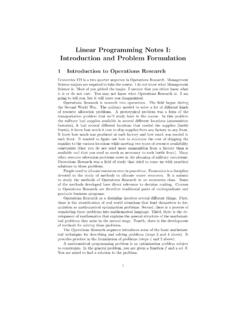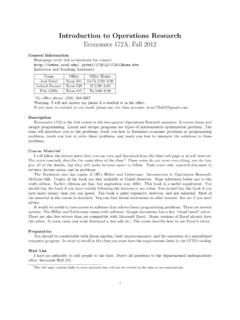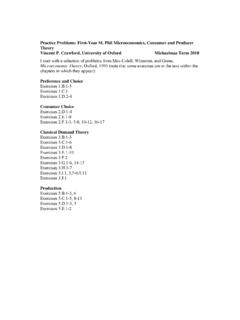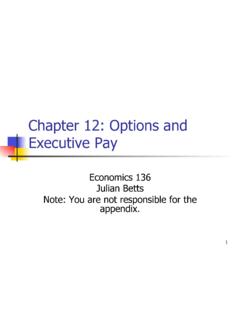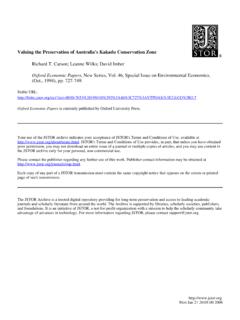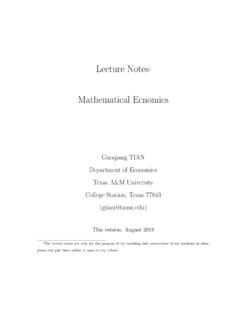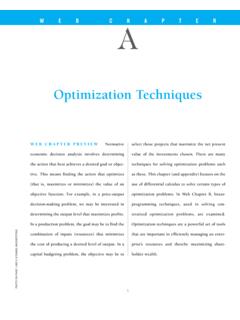Transcription of Linear Programming Notes VI Duality and Complementary ...
1 Linear Programming Notes VIDuality and Complementary Slackness1 IntroductionIt turns out that Linear Programming problems come in pairs. That is, if youhave one Linear Programming problem, then there is automatically another one,derived from the same with an LP written in the form:maxc xsubject toAx b, x 0.(We know from the study of problem transformations that you can write any LPin this form.) I will call this thePrimal. It is useful to keep track of that there arenvariables (components ofx) andmconstraints. Thatmeans thatcisn dimensional,bism dimensional, andAis a matrix withmrows andncolumns. The data of the problem areb,c, andA.
2 Using the sameinformation, we can write down a new LP. This one hasnconstraints andmvariables. The new problem, called theDualhas the form:minb ysubject toyA c, y get the dual by switching around the parts of the Primal. The ob-jective switches from max to min. The constraints switch from to . Thenumber of constraints changes frommton. The number of variables changesfromntom. The objective function coefficients switch roles with the right-handside we have done is switch symbols around. Here are two unrelated questionsthat might have come to mind. What s the point? (This is a good, all-purpose,question.) Why stop at taking the dual of the primal, why not take the dualof the dual and the dual of the dual of the dual and so on?
3 (This is not anall purpose question and probably would not occur to you unless you are reallyinterested in logical manipulation.)The real answer to the first question is that you will see. At least, I hopeyou will see. The Primal and the Dual are not just two Linear programmingproblems formed using the same data. They are intimately related. Knowingsomething about one problem tells you something about the other. The mathe- matical relationship is described in what is called the Duality Theorem of LinearProgramming. I will have a lot to say about this answer to the second question is simple. Before I give the answer, letme explain the question in more detail.
4 I gave you a definition of the dual of alinear Programming problem. Since any LP can be written in the standard formabove, any LP has a dual. Since the dual of a LP is itself a LP, it has a we could keep on taking duals forever. Except that if you take the trouble tofind the dual of the dual (in order to use the definition of Duality you would need1to change the objective function from min to max and reverse the inequalitiesin the constraints), you would find that you get right back to the Primal. If you operate on a LP twice by taking duals you get right back where you startedfrom. Verifying this is a simple exercise in problem transformations.
5 Try ExampleIn this section I will take a Linear Programming problem and write its simple exercise builds on the section on problem (in the section on Problem Transformations) we started with theproblem:min4x1+x2subject to 2x1+x2 6x2+x3=4x1 4x2x3 you want to find the dual of this problem. The first thing to do iswrite it in the form:maxc xsubject toAx b, x 0 Once the problem is in this form, you can apply the definition of the already rewrote the problem (at the end of the previous section)c=( 4,4, 1,0), b= ( 6,4, 4,4) andA= 2 2 10001100 1 1 1100 .Hence the dual of the problem isminb ysubject toyA c, y it out, we have that the dual is to findyto solve:min 6y1+ 4y2 4y3+ 4y4subject to2y1 y4 4 2y1+y4 4 y1+y2 y3 1y2 y3 The Duality StatementIn this subsection, I will state the theorem and try to explain what it 1If problem (P) has a solutionx , then problem (D) also has asolution (call ity ).
6 Furthermore, the values of the problems are equal:c x =b y .If problem (P) is unbounded, then problem (D) is not , if problem (D) has a solutiony , then problem (P) also has asolution (call itx ). Furthermore, the values of the problems are equal:c x =b y .If problem (D) is unbounded, then problem (P) is not Duality Theorem states that the problems (P) and (D) are intimately re-lated. One way to think about the relationship is to create a table of \Dunboundedhas solutionnot feasibleunboundednonopossiblehas solutionnosame valuesnonot feasiblepossiblenopossibleEach of the three rows represents one of three (exclusive and exhaustive)properties of the Primal.
7 That is, (P) is either unbounded, has a solution, or isinfeasible. The columns represent the same features of the Dual. If I grabbedtwo LPs at random, any one of the nine cells could happen. For example, theboth problems could be unbounded. If the two problems are related by Duality ,then five of the nine boxes are impossible. Since one box must be true in eachrow and in each column, at least three of the boxes must be possible. Whatduality does, therefore, is rule out all but one possibility. If you are told that(P) is unbounded, then you know that (D) can t be feasible. If you are toldthat (P) has a solution, then you know that (D) has one too.
8 Only when (P)is not feasible are you uncertain. Maybe (D) is infeasible too or maybe (D) of this information can be summarized in a smaller table. Rememberthat every LP is either feasible or not feasible and that feasible problems eitherare unbounded or have a solution. The next table just divides problems intofeasible and \Dfeasiblenot feasiblefeasibleboth have solutions; values equalP unboundednot feasibleD unboundedpossibleThis table shows that if you know that both problems are feasible, thenyou know that neither problem is unbounded or, equivalently, that both havesolutions. More than that, the values of the solutions are Why is the Duality Theorem True?
9 The Duality Theorem is a piece of mathematics. It requires a mathematicalproof. I will spare you the details. You do not need to know the proof. Oneway to prove the theorem is to examine the simplex algorithm really turns out that the algorithm solves (P) and (D) simultaneously. We willsee that Excel spits out the solution to the dual whenever it solves a proof requires little more than high-school algebra and a willingness totolerate a logical argument. That is, it is elementary. The other proof uses atool from convex analysis called the separating hyperplane theorem. It is withinthe grasp of an undergraduate math major.
10 Although it is not relevant for aManagement Science major, ask and I ll give you though I am not going to prove the theorem, I should make an attemptto tell you why it is true. On the surface it is really amazing. Why should thetwo problems be so closely related? A lazy answer is that they both use thesame data, so they must be related somehow. Here is a slightly better afeasible valuefor (P) I mean a numbervwith that property thatthere is somexsuch thatAx bandx 0, such thatv=c x. In words, ifvis a feasible value that means that there is somexthat satisfies the constraintsthat yields objective function valuev. I define a feasible value for (D) claim that any feasible value for (P) is less than or equal to any feasiblevalue for (D).
